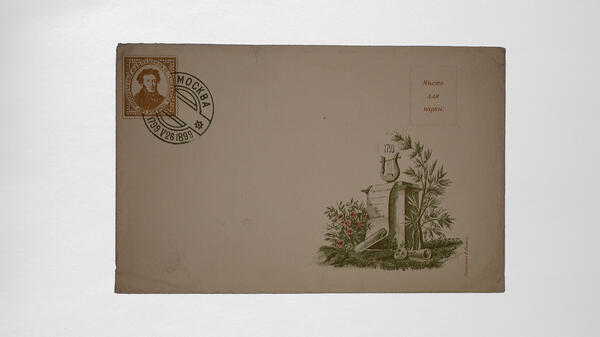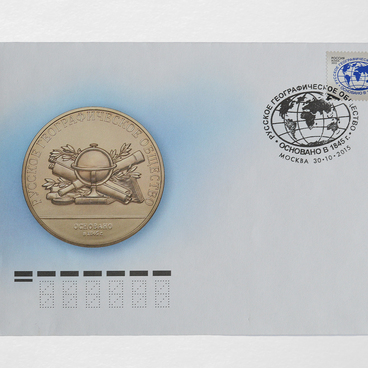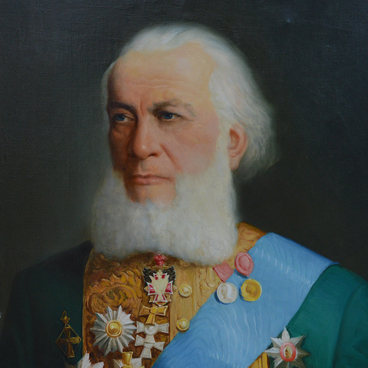The envelope from the museum’s collection was released to mark the centenary of the birth of Alexander Pushkin. In the left corner there is a drawing depicting a postage stamp with a portrait of the poet. In the lower right corner, there is a drawing with the image of lyre and the date of Pushkin’s birth. The scroll contains the lines ‘A rumor about me will pass through all great Russia’ from the poem ‘I erected a monument to myself not made by hands…’.
This is one of the most famous works of the poet. The draft of the poem was discovered by Vasily Zhukovsky after Pushkin’s death. It dates back to 1836. This period was difficult for the poet, as the censorship carefully checked all his works. The poem was first published in a posthumous collection, which was published in 1841. It marked the beginning of disputes among literary critics, which continue to this day.
The first question concerns the source that inspired Pushkin to write this work. Many considered it an imitation of the numerous odes of Russian poets on the theme of the monument (Gavriil Derzhavin and Mikhail Lomonosov). But the more common version was that Pushkin took the main ideas from the ode of the ancient poet Horace. The epigraph to the poem was also taken from there.
The meaning and significance of the work became a more serious stumbling block. The poet’s contemporaries received it coldly. The lifetime praise of his merits, the author’s conviction of his future glory caused bewilderment. To many, this seemed excessive self-conceit and audacity. Friends considered this poem an expression of the poet’s self-irony.
The author of the drawing on the envelope, Varvara Schneider (1860-1942), was an artist, a collector of folk art and a trustee of the School of Folk Art under the patronage of Empress Alexandra Fyodorovna. At the age of 15, Schneider was orphaned, and her uncle, the orientalist Ivan Minaev, took care of the upbringing of her and her younger sister Alexandra. After his death, the girls were taken care of by Pyotr Semyonov-Tyan-Shansky, who called them ‘God-given daughters’.
From 1896 to 1902, Varvara Schneider worked with the art publishing house at the Community of St. Eugenia and was the leader of a group of artists. It was for the society’s benefit that the envelope was issued. Art critic Natalia Mozokhina noted that Schneider was at the origin of the creation of ‘Russian artistic original postcards’. The envelope was presented to the museum by Natalia Semyonova-Tyan-Shanskaya, the great-granddaughter of the scientist.
This is one of the most famous works of the poet. The draft of the poem was discovered by Vasily Zhukovsky after Pushkin’s death. It dates back to 1836. This period was difficult for the poet, as the censorship carefully checked all his works. The poem was first published in a posthumous collection, which was published in 1841. It marked the beginning of disputes among literary critics, which continue to this day.
The first question concerns the source that inspired Pushkin to write this work. Many considered it an imitation of the numerous odes of Russian poets on the theme of the monument (Gavriil Derzhavin and Mikhail Lomonosov). But the more common version was that Pushkin took the main ideas from the ode of the ancient poet Horace. The epigraph to the poem was also taken from there.
The meaning and significance of the work became a more serious stumbling block. The poet’s contemporaries received it coldly. The lifetime praise of his merits, the author’s conviction of his future glory caused bewilderment. To many, this seemed excessive self-conceit and audacity. Friends considered this poem an expression of the poet’s self-irony.
The author of the drawing on the envelope, Varvara Schneider (1860-1942), was an artist, a collector of folk art and a trustee of the School of Folk Art under the patronage of Empress Alexandra Fyodorovna. At the age of 15, Schneider was orphaned, and her uncle, the orientalist Ivan Minaev, took care of the upbringing of her and her younger sister Alexandra. After his death, the girls were taken care of by Pyotr Semyonov-Tyan-Shansky, who called them ‘God-given daughters’.
From 1896 to 1902, Varvara Schneider worked with the art publishing house at the Community of St. Eugenia and was the leader of a group of artists. It was for the society’s benefit that the envelope was issued. Art critic Natalia Mozokhina noted that Schneider was at the origin of the creation of ‘Russian artistic original postcards’. The envelope was presented to the museum by Natalia Semyonova-Tyan-Shanskaya, the great-granddaughter of the scientist.



